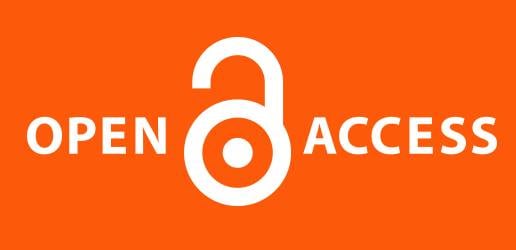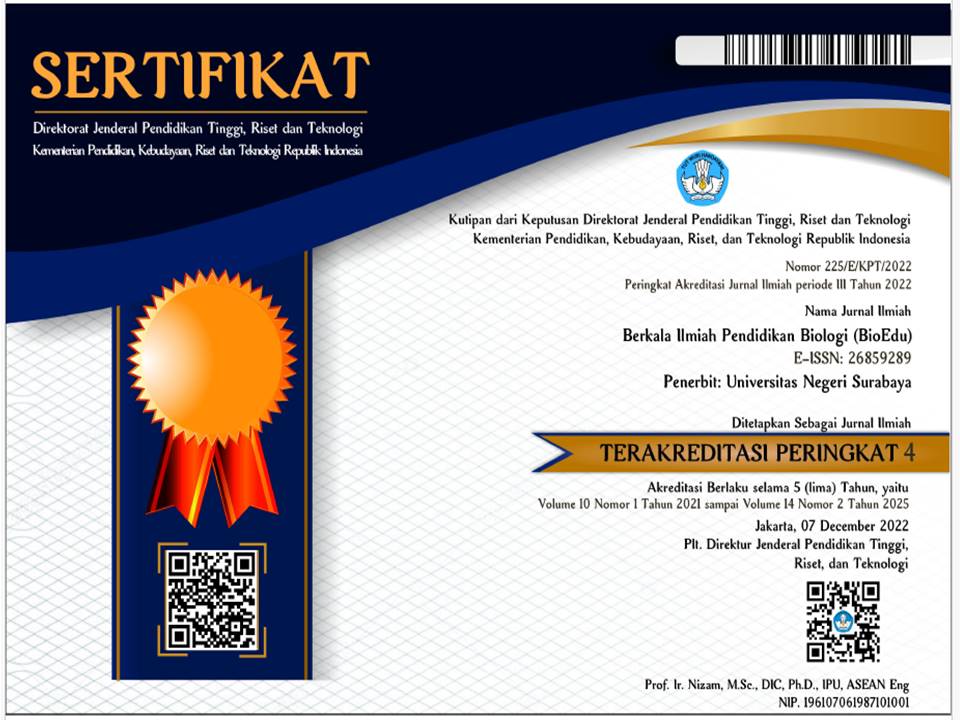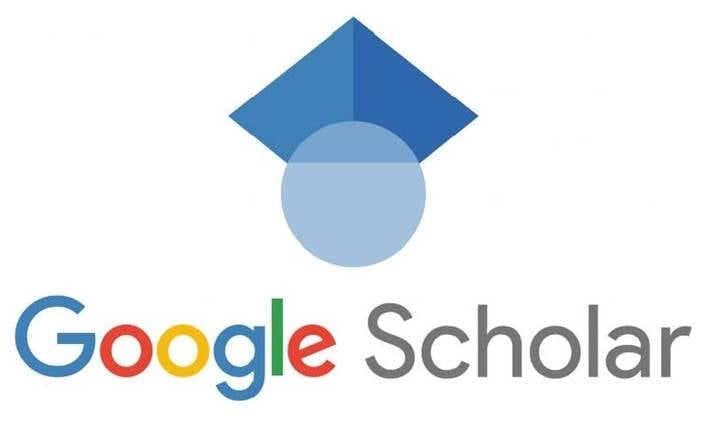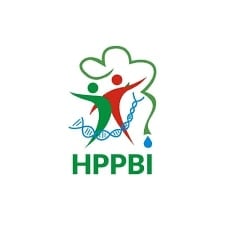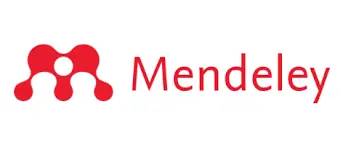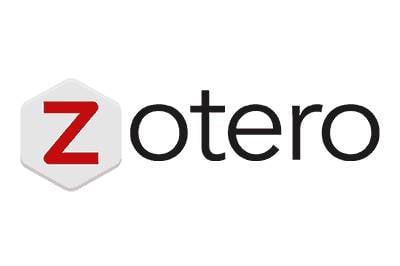Development of ViBot to Train Digital Literacy of 10th Grade High School Student
DOI:
https://doi.org/10.26740/bioedu.v14n1.p219-231Keywords:
media, bot, Telegram, virus, digital literacy, literacy skillsAbstract
The world is transitioning toward Society 5.0, characterized by increasing globalization and advancements in digital technology, leading to substantial societal transformations, including the rise of Artificial Intelligence (AI), the Internet of Things, Big Data, and robots. Education may capitalize on this by utilizing ICT-based learning media accessible via diverse electronic device. Furthermore, it possesses the capacity to improve digital literacy competencies. Telegram is one of the available technologies. A survey conducted among 20 students revealed that 70% utilize the Telegram application, while its use for academic is infrequent. This project aims to create a valid, practical, and effective Telegram bot for acquiring knowledge about viruses. This study employs the 4D method (Define, Design, Develop, and Disseminate). Data were gathered utilizing validation procedures, Fry readability assessments, questionnaires, and examinations. The research trial was conducted on 20 students from Labschool Unesa 1 High School. We examined the gathered data employing descriptive-quantitative methodologies. The research findings indicate that ViBot possesses a high validity score of 3.87, rendering it appropriate for educational purposes; it is regarded as practical according to the readability assessment, which yielded a level 10 and a student response rate of 97.5%; ViBot is classified as highly effective based in the comprehensiveness of digital literacy indicators, achieving a percentage of 83.75%, which falls within the very good category. Consequently, we can ascertain that ViBot is valid, practical, and effective for imparting digital literacy in the 10th grade.
Downloads
References
Agustina, P. (2017). Persepsi Guru Biologi SMA tentang Media Pembelajaran Materi Kingdom Animalia. Proceeding Biology Education Conference, 14(1), 318–321.
Andayani, E. (2021). Efektivitas berbagai macam fitur google sebagai media pembelajaran program studi pendidikan ekonomi. Jurnal Penelitian dan Pendidikan IPS, 15(2), 218-225.
Anggraeni, A. R., Khasanah, N. A., Febias, H. N., Sulistiyono, R., & Martha, N. U. (2022). Keterbacaan Materi Cerita Rakyat Pada Buku Teks Bahasa Indonesia Kelas X Menggunakan Grafik Fry. Jurnal Pendidikan, 13(2), 137-149.
Clark, R. C. (2015). Evidence-Based Training Methods: A Guide for Training Professionals.
Dhanan, A., & Iwan, M. (2021). Penggunaan Aplikasi Telegram Untuk Kegiatan Pembelajaran Jarak Jauh Pada Mata Kuliah Bahasa Inggris Materi Speaking Pada Mahasiswa Universitas Maritim Amni Semarang. Prosiding Kemaritiman 2021.
Garrison, D. R., & Kanuka, H. (2004). "Blended learning: Uncovering its transformative potential in higher education." The Internet and Higher Education.
Gilster, P. (1997). Digital Literacy. Wiley Computer.
Gilster, P. (1997). Digital Literacy. Wiley Computer.
Hague, S., & Payton, S. (2011). Digital Literacy Across the Curriculum. Curriculum & Leadership Journal, 9(10), 1-10.
Hikmat, H. (2022). The Readiness of Education in Indonesia in Facing The Society Era 5.0. Jurnal Basicedu, 6(2), 2953-2961.
Idris, N. S. (2019). Kemampuan Literasi Digital Generasi Digital Native. In Seminar Internasional Riksa Bahasa.
Janan, D., & Wray, D. (2014). Reassessing the accuracy and use of readability formulae. Malaysian journal of learning and instruction, 11, 127-145.
Kalina, C., & Powell, K. C. (2009). Cognitive and social constructivism: Developing tools for an effective classroom. Education, 130(2), 241-250.
Kharisma, H. V. (2017). Literasi digital di kalangan guru sma di kota surabaya. Libri-Net, 6(4), 31-32.
Kurnianingsih, I., Rosini, R., & Ismayati, N. (2017). Upaya Peningkatan Kemampuan Literasi Digital Bagi Tenaga Perpustakaan Sekolah dan Guru Di Wilayah Jakarta Pusat Melalui Pelatihan Literasi Informasi. Jurnal Pengabdian Kepada Masyarakat, 3(1), 61-76.
Kurniawan, C., & Kuswandi, D. (2021). Pengembangan E-Modul sebagai Media literasi Digital pada Pembelajaran Abad 21. Academia Publication.
Kurniawati, I. D. (2018). Media pembelajaran berbasis multimedia interaktif untuk meningkatkan Pemahaman konsep mahasiswa. DoubleClick: Journal of Computer and Information Technology, 1(2), 68-75.
Landoni, M., & Gibb, F. (2000). The role of visual rhetoric in the design and production of electronic books: the visual book. The electronic library, 18(3), 190-201.
Law, N. W. Y., Woo, D. J., De la Torre, J., & Wong, K. W. G. (2018). A global framework of reference on digital literacy skills for indicator 4.4. 2.
Leaning, M. (2019). An approach to digital literacy through the integration of media and information literacy. Media and communication, 7(2), 4-13.
Milenkova, V., & Lendzhova, V. (2021). Digital Citizenship and Digital Literacy in the Conditions of Social Crisis. Computers, 10(4), 40. https://doi.org/10.3390/computers10040040
Mufarocha, S. & Yuliani, Y. (2023). Development of Interactive E-Book on Bioprocess Topic to Train Digital Literacy of Senior High School Grade XI. Berkala Ilmiah Pendidikan Biologi (Bioedu), 12(1), 088-098.
Musthofa, C., Aunurrahman, A., & Fadillah, F. (2020). Pengembangan Multimedia Literasi Digital Untuk Pemahaman Informatika. Jurnal Pendidikan dan Pembelajaran Khatulistiwa (JPPK), 9(10).
Nuraliyah, E., Fadilah, A., Handayaningsih, E., Ernawati, E., & Oktadriani, S. L. (2022). Penggunaan Handphone dan Dampaknya bagi Aktivitas Belajar. Ideas: Jurnal Pendidikan, Sosial, dan Budaya, 8(4), 1585-1592.
OECD. (2019). PISA 2018 Results Combined Executive Summaries Volume I, II & III. Sekretariat Jenderal OECD.
OECD. (2023). PISA 2022 Result (Colume I): The State of Learning and Equity in Education. Paris: OECD Publishing.
Rini, T. A., Cahyanto, B., & Sholihah, F. P. (2020, December). The Portraits of Digital Literacy Awareness Amid Covid-19 Pandemic. In 6th International Conference on Education and Technology (ICET 2020) (pp. 433-437). Atlantis Press.
Sharma, K., Mangaroska, K., van Berkel, N., Giannakos, M., & Kostakos, V. (2021). Information flow and cognition affect each other: Evidence from digital learning. International Journal of Human-Computer Studies, 146, 102549.
Susantini, E., Puspitawati, R. P., Raharjo, & Suaidah, H. L. (2021). E-book of metacognitive learning strategies: design and implementation to activate student’s self-regulation. Research and Practice in Technology Enhanced Learning, 16(1), 13.
Sustainable Development Goals: Goals 4 Pendidikan Berkualitas Diambil 7 Oktober 2024, dari https://sdgs.bappenas.go.id/17-goals/goal-4/
Tarigan, H. G. (2019). Berbicara; ssebagai suatu keterampilan berbahasa.
Telegram LLP. Telegram Bot API. 2023.
Ulumudin, I., Mahdiansyah, M., & Joko, B. S. (2017). Kajian buku teks dan pengayaan: Kelengkapan dan kelayakan buku teks kurikulum 2013 serta kebijakan penumbuhan minat baca siswa. Jakarta: Pusat Penelitian Kebijakan Pendidikan dan Kebudayaan, Balitbang, Kemendikbud.
Western Sydney Univesity. Digital Literacy: What is digital literacy? Diambil 5 Juli 2024, dari https://www.westernsydney.edu.au/studysmart/home/digital_skills
 Abstract views: 568
,
Abstract views: 568
, PDF Downloads: 117
PDF Downloads: 117

